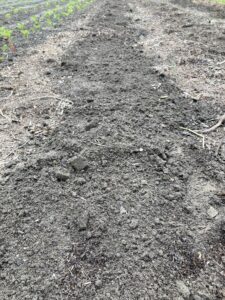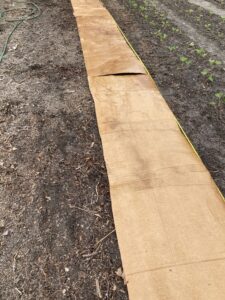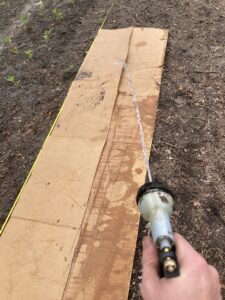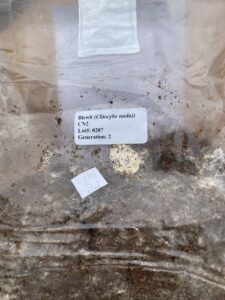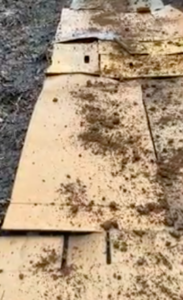Final report for FNE22-014
Project Information
The goal of this project was to improve soil tilth of clay soil with mulch and mushroom mycelia.
We measured bulk soil density with soil probe and by drying out samples and dividing by soil probe area to find the grams per cubic cm; spread mulch and mycelia across permanent beds.; and measured bulk soil density of beds after one year and two years of initial spreading of mulch and mycelia. Maximum soil density reduction was by 5%, and some beds showed an increase in soil density of up to 15%.
The results were presented to Assateague Coastal Trust and the Worcester County Garden Club.
Original objectives:
This project seeks to improve clay soil tilth with mushroom mycelium, making our heavy soil more friable. This project also seeks to show that plants' roots are more extensive after growing in soil improved with mushroom mycelium, and that yields are noticeably larger due to improved root health, access to nutrients.
Goat Plum Tree Farm anticipates greater root growth of beets, beans, peas, tomatoes and other crops, and that as consequence the yields of those crops will be greater.
We will compare length of roots of sample crops from beds inoculated with gourmet mushroom mycelium, and length of roots of crops from beds not inoculated. We will measure the weight yielded of both the control and variable samples.
Other farmers who grow in clay rich soil will know better ways to cultivate, and improve the tilth of their heavy soils.
Changes to the Scope of the Project, and Challenges
The original goal of the experiment was to demonstrate Improving Soil Tilth and Productivity with Mycorrhizal and Saprophytic Mushrooms. I would use almond agaricus, blewit, shaggy mane, paddy straw, and parasol to demonstrate that my heavy clay soil, black bottom, would be loosened by sowing these mycelia. I also planned to demonstrate that the vegetables and fruit grown in the same beds as the mycelia would show increased yields due to greater nutrient and water access. I hypothesized that the mycelia would help channel nutrients and water to the crops’ roots. Crops grown with mycelia would present greater root structure due to softened tilth and greater access to nutrients compared to crop without mycelia amended soil.
There were many challenges that caused me to change the scope of the project. Vegetable seedlings need to be visited multiple times a day for watering, temperature and airflow adjustments. I was often on the farm and away from the indoor seedlings during the majority of the day. I tended to the seedlings in the morning and evening only. Initially, I wanted to document mycelia effects on blackberries, cantaloupe, cauliflower, onions, peas, watermelon, and winter squash. I was unable to raise the cauliflower, and onions past their start tray stages, and my infield peas and winter squash crop failed. Cauliflower was to be inoculated with blewit, onions with blewit, and peas with parasol. Additionally, I was unable to schedule time to inoculate blackberries, watermelons, and cantaloupes. Blackberries were to be inoculated with almond agaricus. Watermelons and cantaloupes were to be inoculated with paddy straw.
The goal was to originally compare the soil bulk density of the treatment sites versus the control sites, measure the root lengths of select inoculated plants versus the uninoculated plants, and weigh the yields of select inoculated plants versus uninoculated plants. The goal now is to simply compare the soil bulk density of the treatment sites versus the control sites.
The soil densities of the treatment and control sites were measured in 2022, 2023, and 2024, and then compared.
Many farmers cultivate in clay rich soil. Clay rich soil presents a few significant issues for vegetable and fruit farmers. Clay soil retains water very well, and if the soil is extremely clay rich then it may be difficult for the soil to drain. Clay rich soil with a drainage problem may cause extra disease pressure such as fungal infection problems, or roots that are susceptible to rot. Heavy clay soil may flood more dramatically, and stay wet for longer. Clay rich soil may also be difficult for plants' roots to penetrate, or grow deeply for access to important micronutrients. Heavy clay soil can be more difficult to plant into. Because clay is so heavy and dense, it may be hard to sow seeds, to give seeds good soil contact at the right depth, or to plant transplants. Many crops do not do well being grown in clay soil. Clay dominant soils do not provide optimal porosity for plants' roots to channel through.
Mushroom mycelia is one cell wall thick, but extremely powerful. Shaggy mane mycelium has been reported to break through asphalt. Mycelium is very apt at going through small, tight spaces. Mycelia have the ability to break down rock via enzyme and acid chemical processes. Clay is inert just like different types of rock. Therefore, mycelia has the ability to break up the hardpan of dense clay soils. Meanwhile, mycelia has the ability to breakdown organic matter to its elemental building blocks and incorporate that matter into the soil ecosystem at large. Thoroughly incorporating organic matter into soils is important for the creation of viable soil tilth.
Sowing mycelium in clay rich soil with sheet mulches of organic matter such as cardboard, leaves and straw will improve the porosity of clay soil, creating channels for plants' roots to follow, extend plants access to nutrients, and ultimately benefit crop yields.
Evidence showing that sowing and cultivating mycelium and gourmet mushrooms in soils has the potential to improve tilth, root systems, and increase crop yields can be examined from studies like from Fungi Perfecti as detailed in Mycelium Running by Paul Stamets, and by the study conducted by Levi Lilly at UMASS Amherst titled the Impact of Oyster Mushroom Mycelium on the Growth of Kale and Forage Radish
Our farm started out by trying to grow a wide array of vegetables, some log grown mushrooms, and some strawberries in 2020. In 2021, we continued to pursue growing vegetables, log grown mushrooms, and strawberries, and added hosting our own Mushroom 101 and Foraging Classes. By 2022, we had greatly pivoted to focusing more on fruits having planted blackberries in 2021, and expanded our strawberry production, and we continued with mushroom foraging classes, and added Make Your Own Shiitake Mushroom Log Classes. By 2023, we were focusing on entirely on growing fruits, and hosting our mushroom classes in the shoulder seasons. In 2024, we have grown from one consistent farmers market in Berlin, MD over the last four years to now attending three this year including Berlin, and Lewes and Bethany's Sea Colony in Delaware.
Cooperators
- - Technical Advisor
Research
Revised Methods – Obtaining Soil Samples; Measuring, Calculating and Recording Soil bulk densities
Prior to inoculation a standard soil probe was used to sample the treatment and control sites. Two samples were extracted for each of the 9 total beds that are the test subjects. Each of the three mycelia cultures has three 50 feet by two and a half feet beds designated for it. Three beds for parasol and its controls, three beds for blewit and its controls, and three beds for shaggy mane and its controls. The samples for blewit were designated as Blewit Treatment 1 (BT1), Blewit Control 1 (BC1), Blewit Treatment 2, and Blewit Control 2, and so on. The samples for parasol were designated Parasol Treatment 1 (PT1), Parasol Control 1 (PC1), and so on. The samples for shaggy mane were designated Shaggy Mane Treatment 1 (ST1), and Shaggy Mane Control 1 (SC1), and so on. In order to calculate the soil bulk density, it was necessary to obtain the same volume of soil core each time the soil was sampled. The method for determining the area of each soil core was to determine the height and diameter of the cylindrical soil probe and solve for the volume of the cylinder. After measuring the height and diameter of the soil probe, the math is as follows:
Convert height from inches to cm = 6 in = 15.24 cm = h
2 cm = diameter of probe
Volume of cylinder = π*r2*h = π*1cm2*15.24 cm = 47.88 cm3
Samples were measured with a standard soil probe with a cubic area of 47.88 cm3
In order to calculate the soil bulk density, the samples were dried, weighed in grams and then each weight was divided by 47.88 cm3. The weights and bulk densities are reported on the chart titled Soil Bulk Densities in the Results section.
The method for drying the soil samples in order to calculate the empirical soil bulk density was to place each soil sample in a microwave and heat for four minutes, weighing the sample, and then heating the sample at least once more for four minutes. The sample is dry once the same weight measurement was obtained two consecutive times. Upon the sample being dry, the weight in grams was recorded.
Methods - Mycelium Treatment Inoculation
The method for inoculation is detailed in the following passages. Three 50 feet by two and a half feet beds were used to test blewit, three 50 feet by two and a half feet beds were used to test parasol, and three 50 feet by two and a half feet beds were used to test shaggy mane. They were inoculated, sans fruit or vegetable culture, in a hugelkultur style. Three of those beds received four fifths treatment of blewit culture, and one fifth of each was left as the control. Three other beds received four fifths treatment of parasol culture, and one fifth of each was left as the control samples. Three 50 feet beds of strawberries were used to test shaggy mane culture. Four fifths of each bed received the treatment of shaggy mane inoculation while one fifth of each bed was left uninoculated as the control samples.
The blewit beds were inoculated on May 12-13, 2022. The method for blewit inoculation was clearing three beds of weeds, laying layers of corrugated cardboard, wetting the cardboard, spreading out a two thirds bag of a five-pound sawdust spawn bag or three and thirty three hundredths of a pound, and encasing with six inches by two and half feet by 40 feet of composted hardwood leaves and pine needles. The ratio of leaves to pine needles was seven eighths composted hardwood leaves and one eighth pine needles. First, the cardboard was laid on the bare soil, then wetted. Next, a layer of blewit culture was spread, and then a layer of composted leaves and pine needles. Another layer of cardboard was laid, but this time it was shredded into smaller pieces ranging from 16 square inches to one square foot. After the smaller cardboard pieces were laid out, another layer of blewit culture was spread, and finally encased with more composted leaves and pine needles.
The parasol beds were inoculated on May 23, 2022. The method for parasol inoculation included spreading the culture, dead grass clippings, aged hardwood and pine wood chip mulch (at a three quarters hardwood to pine ratio), and cardboard across 40 feet of each of three 50 feet beds. First, dead grass clippings were laid down to a depth of one inch. Next, corrugated cardboard pieces ranging for 16 square inches to one square foot were laid on the bed, and then parasol sawdust spawn was spread over the cardboard. Lastly, aged composted wood mulch was spread across the bed to a depth of six inches, across the width and length of the bed.
The shaggy mane beds were inoculated on May 25, 2022. The method for shaggy mane inoculation included clearing the beds of weeds, laying down aged horse manure, adding the shaggy mane culture, and adding straw. First, the beds of strawberries were rid of all their weeds. Each bed has two rows of strawberries. The first row of strawberries is six inches from the adjacent pathway and the second row of strawberries is six inches from its nearest pathway, this leaves one and a half feet between the two rows of strawberries in each bed. The treatment and control sections of each bed are hosted in these middle areas. A one inch layer of aged horse manure was spread between each row of strawberries for forty feet. Next, a dressing of shaggy mane culture was spread on top of the manure then a layer of straw on top. A second layer of shaggy mane culture was placed on the straw, and a final casing of straw placed on top. The total amount of shaggy mane culture placed on each forty feet section equaled two thirds of a five-pound bag of sawdust spawn or three and thirty three hundredths of a pound. The total amount of straw equaled three inches high by 40 feet long by 18 inches wide.
After inoculation the beds required regular watering totaling approximately one inch of well water, or rainfall per week. The beds were watered Monday through Friday from late May until September in 2022 and 2023. Each bed was watered when rainfall was not sufficient. When rainfall was not present each bed received approximately 10 minutes per day of hand watering, an average of 4.5 days per week, and an hour of drip irrigation from three different drip lines on each bed over an average of 5 days per week.
Blewit bed cleared of weeds.
Cardboard laid on blewit bed.
Soaking cardboard before inoculation.
Five pound bag of blewit spawn.
Blewit spawn added to bed.
Covering blewit inoculated cardboard with composted leaves.
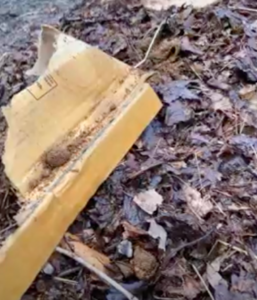 Additional layer of shredded cardboard and blewit spawn.
Additional layer of shredded cardboard and blewit spawn.
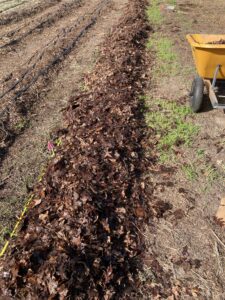 Final casing layer of composted leaves. Blewit bed inoculation completed.
Final casing layer of composted leaves. Blewit bed inoculation completed.
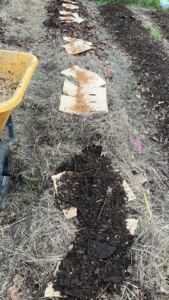 Parasol beds with dead grass clippings, shredded cardboard, parasol culture, and composted hardwood and pinewood chips. Completed parasol beds in the right of picture.
Parasol beds with dead grass clippings, shredded cardboard, parasol culture, and composted hardwood and pinewood chips. Completed parasol beds in the right of picture.
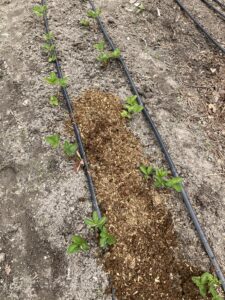 Strawberry beds cleared of weeds, applied aged horse manure.
Strawberry beds cleared of weeds, applied aged horse manure.
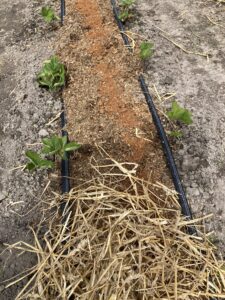 Shaggy mane culture applied on top of manure. Casing of straw on top of manure and shaggy mane culture.
Shaggy mane culture applied on top of manure. Casing of straw on top of manure and shaggy mane culture.
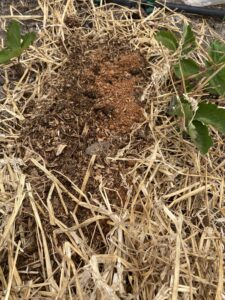 Additional layer of manure and shaggy mane culture on top of straw.
Additional layer of manure and shaggy mane culture on top of straw.
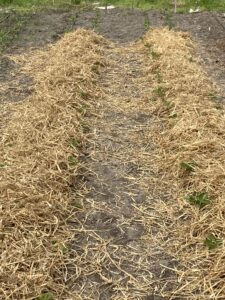 Final layer of straw casing. Shaggy mane bed inoculation completed.
Final layer of straw casing. Shaggy mane bed inoculation completed.
Summary of Time Spent on Project
The total documented time spent on the research including marking and preparing beds, the soil sampling, weighing of samples (four hours), recording of sample weights, bed preparation (eight hours), inoculation, conservatively estimating my watering time per week to be two hours per week over 18 weeks (36 hours), and writing this report (6 hours) equals 56 hours.
The total documented time spent on the research including marking and preparing the beds, soil sampling, preparing substrate material, ordering mycelia material, inoculating beds, weighing soil samples, recording sample weights, watering the beds each week, interpreting the date, and writing this report are detailed in the following charts:
Time Spent Soil Sampling and Delineating Beds in 2022 - 2024
Dates and Times of Inoculation Events
Watering Dates and Times of 2022, and 2023
Time Spent Weighing Samples and Recording Soil Densities 2022 - 2024
Time spent with initial soil sampling and delineating the beds in 2022 took 2 hours.
Time spent inoculating in 2022 took 11 hours and 20 minutes.
Time spent watering by hand took 110 hours in 2022 and 110 hours in 2023.
Time spent watering using drip irrigation took 148 and a half hours in 2022, and 148 and a half hours in 2023 for a total of 517 hours.Time spent hand watering was done approximately 3 - 6 days a week from late May through September. During hand watering, each of the nine beds would receive ten minutes of watering for a total of one and a half hours for the day. Time spent watering with drip tape was used more consistently and used in tandem with hand watering when the days were particularly hot. During drip tape watering, each of the nine beds had three drip lines and received an hour of drip irrigation approximately 3 - 7 days a week.
Time spent weighing the samples and recording the data took 2 hours in both 2022 and 2023 for a total of 4 hours.
Time spent writing the report through February 2, 2024 has taken 14 hours and 25 minutes.
Total time spent on the entirety of research has taken 328 hours and 45 minutes.
Soil Bulk Densities of 2022, Prior to Inoculation, Compared to Post Inoculation Densities in 2023
Bulk Densities of 2022, 2023, and 2024
In late March of 2023, the treatment and control locations will be sampled again, and the same process of drying, weighing and recording the sample weights will be repeated. The watering schedule will continue as noted above. If any mushrooms grow in the 2023 season, their general harvests will be noted.
Additional questions I am considering are will there be a change in bulk density to the clay soil below the inoculation sites. The mycelia are inoculated on top of the clay soil we hope will undergo a change in tilth to become more loose and cultivatable. I wonder whether the mycelia will affect the clay soil or only the media it was sown into. I will need to sample the soil from the same insertion points the soil probe initially entered as before so any empirical bulk density change may be noted. I will need to move away the mycelia media in order to sample from the same points.
The averages of each culture's treatment and control samples in 2022 was used to draw conclusion numbers. In 2022, prior to inoculation, the range of soil bulk density, including the control and treatment sites, was .94 - 1.02 grams/cm3, the median was .975 grams/cm3, and the mean was .978 grams/cm3. Examining the control sites independently produced a range of .94 - 1.02 grams/cm3, a median of .97 grams/cm3, and a mean of .976 grams/cm3. Examining the treatment sites independently produced a range of .96 - 1 grams/cm3, a median of .98 grams/cm3, and a mean of .98 grams/cm3.
The averages of each culture's treatment and control samples in 2023 was used to draw conclusion numbers. The control site figures in 2023 include a range of soil bulk density from .94 - 1.28 grams/cm3, a median of 1.11 grams/cm3, and a mean of 1.11 grams/cm3. The treatment site figures in 2023 include a range of .73 - .97 grams/cm3, a median of .81 grams/cm3, and a mean of .836 grams/cm3.
The averages of each culture's treatment and control samples in 2024 was used to draw conclusion numbers. The control site figures in 2024 include a range of soil bulk density from 1.002 - 1.12 grams/cm3, a median of 1.08 grams/cm3, and a mean of 1.06 grams/cm3. The treatment site figures in 2023 include a range of .77 - 1.16 grams/cm3, a median of .98 grams/cm3, and a mean of .97 grams/cm3.
Comparing the control sites in 2022 to the control sites in 2023, in two of the three average data points we note an increase in density in both the parasol and blewit sites. Regarding the bulk densities of the parasol control sites, an increase from .97 grams/cm3 to 1.28 grams/cm3 is noticed. Concerning the bulk density of the blewit control sites, an increase from 1.02 grams/cm3 to 1.11 grams/cm3 is documented. Comparing the shaggy mane control sites of 2022 and 2023 did not yield a change in density, staying the same at .94 grams/cm3.
Comparing the pre-inoculation treatment sites of 2022 to the post-inoculation sites of 2023, a decrease in density is noted in all three sample averages. On the low end, the density of shaggy mane treatment sites from 2022 to 2023 showed a slight decrease from .98 grams/cm3 to .97 grams/cm3. The second largest density decrease was the parasol treatment sites with 1 gram/cm3 down to .81 grams/cm3. The largest decrease was seen with the blewit treatment starting with a density of .96 grams/cm3, and a decrease down to .73 grams/cm3.
Comparing the treatment sites of 2023, to the treatment sites of 2024 shows an increase in soil density in all but two of the treatment sites. In BT3 the density decreased from .87 grams/cm3 to .77 grams/cm3, and in ST2 the density decreased from 1.04 grams/cm3 to .98 grams/cm3.
Comparing the control sites of 2023 to the treatment sites of 2024 shows an decrease in density of the Parasol Controls from an average of 1.28 grams/cm3 to 1.01 grams/cm3. The blewit controls from 2023 to 2024 shows a decrease in density in two of the three samples. The shaggy mane controls from 2023 to 2024 shows an increase in density of all of the controls, from an average of .94 grams/cm3 to 1.1 grams/cm3.
Comparing the 2022 samples to the 2024 samples an increase in density was most commonly noticed.
Parasol Treatment:
A 5% average reduction in density.
Parasol Control:
A 4% average increase in density.
Blewit Treatment:
A 2% average increase in density.
Blewit Control:
A 5% average increase in density.
Shaggy Mane Treatment:
A 2% average increase in soil density.
Shaggy Mane Control:
A 15% average increase in soil density.
I sought to increase the friability of my soil, to reduce the density of our clay rich soil. We spread varieties of mulches and tested various treatments of mycelia content on several beds. We compared treated beds with mulches and mycelia to controlled beds without any mulches or mycelia. We expected to see a decrease in soil density from 2022 to 2024 in the portions of beds that were treated with mycelia. Between the treatment and control beds of blewit, shaggy mane, and parasol; only the parasol treatment beds yielded a 5% average reduced density. All other beds, whether treatment or control, resulted in increases in density of between 2% and 15%. I believe more beds would have shown marked decreases in density if additional mulch had been added to each bed over the course of each year, and this would be another aspect of this experiment worth pursuing under an altered hypothesis. Another aspect of this experiment worth pursuing under a revised hypothesis would be adding mycelia during each spring or fall for each year of the experiment.
Education & Outreach Activities and Participation Summary
Participation Summary:
The research was presented to the Friends of the Ocean Pines Library in Berlin, MD on October 23, 2023.
The research was presented to Assateague Coastal Trust and the public at the Coast Taphouse in West Ocean City, MD on March 28, 2024.
The research and final figures was presented to the Worcester County Garden Club in Berlin, MD on April 7, 2024.
Friends of Ocean Pines Library Presentation 10/23/2023
Worcester County Garden Club Presentation 4/7/2024
Learning Outcomes
The project results have reemphasized to me the importance of mulching for improving soil tilth and soil health in general. The increase in soil density from 2023 to 2024, without the addition of more mycelia or the addition of extra mulch, demonstrates the importance of continuing to add organic material to beds, not only for added tilth, but for added nutrients and habitat for beneficial insects.
Project Outcomes
Keeping plots and beds covered is an essential part of weed management, that has multiple collateral benefits including increased worm activity, better water retention, increased integration of nutrients from mulch into soil, and greater overall plant health. It is possible that added mulch alone improves the soil density of clay rich soils, it is also possible that with the addition of mycelia and mulch that soil tilth is more greatly improved. For all of these reasons, I would always strived to add organic mulch to my beds of annual and perennial fruits, and would consider adding mycelia for potential added benefits to tilth.
I believe my results would have been more positive if I was periodically adding extra mulch and mycelia to the beds. I would have compared beds that only received an initial application of mycelia and mulch to beds that had received periodic applications of both inputs. I do not feel that I have fully answered the questions I set out to study, and I feel that my results have left me with inconclusive evidence as to whether mulch and mycelia applications have an impact on soil density. Work should be done to compare amounts of mulch, as well as types, in tandem with mycelia applications, and in comparison to initial applications versus periodic applications. I feel that those growing in heavy clay soil environments, those growing in sandy soils, and those who are growing on former wetland ecosystems would benefit from exploring this experiment, and it's purported solutions.
